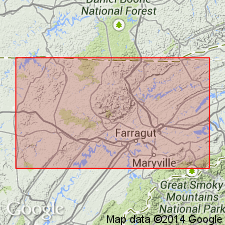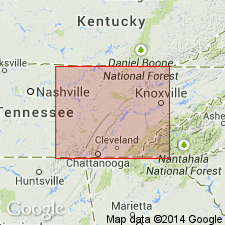
- Usage in publication:
-
- Pilot Knob sandstone
- Modifications:
-
- Original reference
- Dominant lithology:
-
- Sandstone
- AAPG geologic province:
-
- Appalachian basin
Summary:
Pg. 23, 33, 319. Pilot Knob sandstone. Very prominent cliff-making coarse gritty sandstone, 20 to 40 feet thick in Briceville region, where it lies 300 to 320 feet above the Big Bench, and 80 feet thick on Pilot Knob, where it lies about 250 feet above the Big Bench. Is basal member of Anderson formation. Its base is 450 feet beneath highest point on Pilot Knob. Is believed to be unconformable on Scott formation. Age is Pennsylvanian.
Recognized in Northern Tennessee coal field.
Source: US geologic names lexicon (USGS Bull. 896, p. 1660).

- Usage in publication:
-
- Pilot Knob sandstone member[†]
- Modifications:
-
- [Abandoned]
- AAPG geologic province:
-
- Appalachian basin
Summary:
Pg. 11, pl. 4. Pilot Knob sandstone member of Anderson formation. Renamed Pilot Mountain sandstone because name Pilot Knob is preoccupied. [See Pilot Mountain.]
Source: US geologic names lexicon (USGS Bull. 1200, p. 3023).
For more information, please contact Nancy Stamm, Geologic Names Committee Secretary.
Asterisk (*) indicates published by U.S. Geological Survey authors.
"No current usage" (†) implies that a name has been abandoned or has fallen into disuse. Former usage and, if known, replacement name given in parentheses ( ).
Slash (/) indicates name conflicts with nomenclatural guidelines (CSN, 1933; ACSN, 1961, 1970; NACSN, 1983, 2005, 2021). May be explained within brackets ([ ]).

